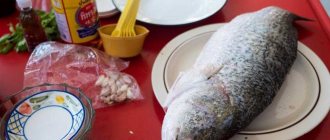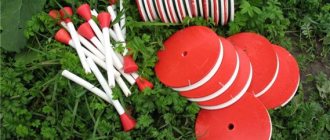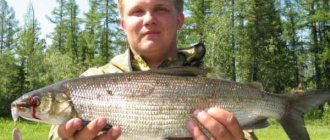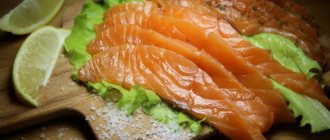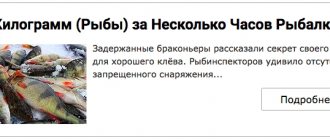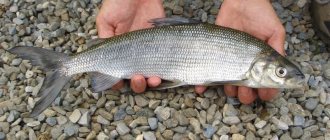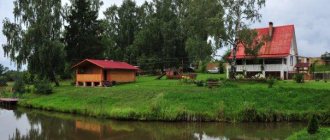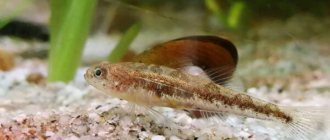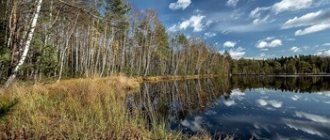The salmon family includes dozens of fish. One of the most interesting and valuable is whitefish. Whitefish is a commercial fish valued for its meat, which has virtually no bones. The Latin name for whitefish is coregonus, which translates as corner or pupil. The fact is that this type of fish has an angular pupil, and it is because of this feature that the fish got its name. The whitefish genus is very extensive. Ichthyologists count over 60 species of whitefish. The most famous types of whitefish are migratory, omul, and nelma. Migratory whitefish include the goat whitefish, loduga and others. Whitefish is the oldest fish. This representative of ray-finned fish appeared on the planet at the end of the Silurian period. The fish was first described by scientist Carl Linnaeus in 1758.
The appearance of whitefish varies depending on the subspecies, however, there are features common to all whitefish. All fish have silver scales with black fins. The head is large and flat relative to the body. The body is oblong and wide. Whitefish almost always lack upper teeth, and the mouth opening itself is poorly developed. This is due to the fact that fish do not hunt large prey. Females are distinguished from males by larger scales and larger size. The color of whitefish meat is white, despite the fact that it belongs to salmon, which have red or coral colored meat. That is why whitefish is called white fish. Whitefish is a freshwater fish, and only the Siberian subspecies can live in desalinated seawater.
Whitefish size
The size of the whitefish varies depending on its subspecies. Whitefish of small forms reach a length of up to 20 centimeters, and whitefish of large forms can grow up to 1 meter. Lake whitefish often reach a size of 70-80 centimeters. As a rule, whitefish live up to 17-20 years. The catches are dominated by individuals aged 10 years. The maximum weight of a whitefish caught was 12 kilograms, but this is an exception to the rule. Often the weight of a small form of fish is 1 kilogram, and large representatives can weigh 5-6 kilograms. Females are larger than males.
Whitefish spawning
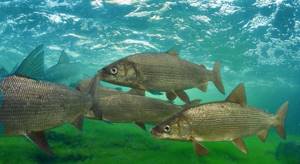
Since the life expectancy of whitefish is quite long, they reach sexual maturity quite late. Males become sexually mature after 4 years, and females closer to 6 years. Fish usually spawn in the fall. Whitefish spawning begins in mid-September and can last until December. Before they begin to spawn, the fish form numerous schools. Whitefish are divided into three species, depending on their spawning location. River whitefish spawn within the river in which they live, with the only difference being that they can travel up the river. Lake whitefish spawn within the lake. Lake-river whitefish live in the lake, but go to the river to spawn. The optimal water temperature for throwing game is up to 5 degrees above zero. Females lay about 30 thousand larvae. For spawning, the female chooses a backwater with rich vegetation. Whitefish spawn annually. After spawning, the fish swims away, and the eggs wait to hatch. After emerging from the egg, the larva is very small. Its size barely reaches a centimeter. The future fish spends about 40 days in the larval stage. All this time the larva does not leave the place of its appearance. It grows and feeds on plankton. The larva becomes a fry when its length reaches 4 centimeters. At this time, the small predator actively feeds on crustaceans and insect larvae. Gradually, the fish begin to move along the river and actively hunt for small fish. By the age of one year, the fry become juveniles.
Of much greater commercial importance are Ladoga whitefish. Currently, the main commercial whitefish here is ludoga. This whitefish is a lake whitefish feeding in the open part of the lake. In the fall, at the time of spawning, it goes to the shores, and here it is caught. A lot of this whitefish migrates to the Neva, Vrlkhovskaya and Svirskaya bays, and it is found throughout the lake. This whitefish got its name from the fact that it is usually caught on luds, where it lays eggs. Ludoga usually weighs less than a kilogram, but individuals have been recorded weighing 4.9 kg. In addition to Ludoga, lake Ladoga whitefish is also found here. In the northern part of Ladoga, at depths of 50 m and more, lives the deep-sea Yam whitefish, the Valaamka, sometimes called the goiter whitefish. It received its first name from the habitat where it was especially numerous - near the island of Valaam. The second is explained by the following circumstance: when a fish is raised from the depths to the surface, the gases in its swim bladder expand, and the bladder increases! in size and, pressing on the internal organs of the fish, bulges the abdomen (it becomes similar to a crop). These whitefish are also small, rarely up to 2 kg. Similar whitefish are found in many deep-sea lakes.
The most famous whitefish of Lake Ladoga is the Volkhov whitefish, or sigolov
. This whitefish inhabits mainly the southern part of Ladoga, from there it rises to spawn in Volkhov and in small numbers in Syas. Before the construction of the Volkhov hydroelectric power station in 1926, the sigblow walked along the Volkhov to Ilmen, and from there to the Meta River, where it spawned. The movement to the Volkhov began early in the spring and lasted all summer until the beginning of autumn; the mass appearance of whitefish at the Volkhov rapids occurred in late August - September. This is a typical passing whitefish; Due to the long migration route, Volkhov whitefish is distinguished by its high fat content and hence its excellent taste. After spawning, some fish immediately migrated to Ladoga, others lingered in Meta, Ilmen and Volkhov until the next year.
The Volkhov whitefish weighs on average about 1 kg, although fish up to 4.5 kg have been encountered. After the construction of the dam on the Volkhov, its spawning grounds were completely cut off. A special fish ladder was built for the spawners going up the river, but due to design flaws, it did not fulfill the task assigned to it. To preserve the Volkhov whitefish, the Volkhov fish hatchery was built, where this valuable fish was supposed to be artificially reproduced. From the breeders caught under the dam, eggs are obtained in the fall, which are incubated, and in the spring the young are released into the river. At first, the efficiency of the plant was low due to the lack of pools or ponds for raising juveniles. Whitefish numbers have fallen. In recent years, the plant began to raise juveniles and release them into the river when they are more viable. In addition, the fish ladder was recently reconstructed and whitefish began to rise into the upper pool. Apparently, the measures taken will increase the number of this whitefish.
Currently, the Volkhov whitefish is included in the Red Book of the USSR.
Whitefish, similar to the Volkhov whitefish in their structure and biology, also enter other rivers of Ladoga. The whitefish of Lake Onega are similar to the Ladoga whitefish, of which the most famous is the Cholmuzh whitefish of northern Onega, individual specimens of which weigh up to 10 kg. This is a deep-sea whitefish, similar to the Ladoga Valaam.
The Chud whitefish lives in Lake Peipus and Lake Pskov. It sometimes spawns in rivers, but most often - near the shores of the lake in sandy shallows, sometimes at a depth of less than 1 m, in late October - November at a water temperature slightly above 0 ° C. This whitefish is quite large, some fish weigh more than 3.5 kg. It differs from other whitefish in its larger body height. Smelt plays a significant role in the nutrition of this whitefish. Whitefish are caught mainly in autumn and winter from under the ice.
Nowadays this species has become scarce and its fishing is prohibited. Recently, as a result of conservation measures, the number of this fish in Lake Peipsi has begun to increase.
Peipus whitefish, whitefish and Ladoga ripus turned out to be surprisingly successful objects for acclimatization. They were successfully introduced not only into the lakes of Leningrad and adjacent regions, but also into many lakes throughout the Union and other countries. The Chud whitefish was one of the first objects of Russian fish farming and acclimatization. For these purposes (under the name “Russian whitefish”) it was exported to other countries.
As noted, in turn, omul was released into Lakes Ladoga and Onega - some of its specimens are already being caught by fishermen. In many lakes they began to grow Siberian whitefish: peled, broad whitefish, muksun and their hybrids. Peled grows especially successfully in our lakes; some of its specimens already weigh up to 500 g in the second year, and up to 1 kg or more in the third year. Peled feed on plankton, which in most of our lakes is used only by trash fish. If you catch weed fish from such lakes and introduce peled fry there, they will grow very quickly without encountering competition. Peled does not breed in our lakes, so after catching commercial fish, the reservoirs must be stocked again. Integrated cultivation of peled, together with broadleaf and carp, is one of the most promising areas in the development of cultural commercial farms on small lakes. The juveniles of these fish are obtained at special fish hatcheries, where breeding broodstock are kept. The main such base in the Leningrad region is the Central Experimental Station “Ropsha” near Leningrad. Here, GosNIORKh employees, together with the station’s fish breeders, carry out genetic selection work with producers of not only various types of whitefish, but also other fish.
Whitefish habitats
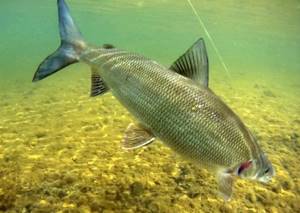
Whitefish, as a representative of salmon, loves cool and clean water. Oxygen-enriched water is what whitefish need for a comfortable life. If one of these points is missing, the whitefish will leave the area or die. The habitat of whitefish in Russia is extensive. This wonderful fish lives in many rivers and lakes in the northern region of the European part of the country. There is a lot of fish in the basins of the White Sea, as well as in the rivers of the Kola Peninsula. It is represented everywhere in the Gulf of Finland, Lakes Ladoga and Onega, in the Volkhov River, Northern Dvina. The rivers and lakes of Karelia are rich in whitefish. Can be found in the Baltic. Some types of whitefish are common in Lake Baikal, as well as in the Arctic Ocean. Whitefish also lives outside of Russia. Distributed in rivers of England, Switzerland and the USA. The rivers of the northern hemisphere have become home to this fish. Prefers to stay in the middle layers of water or sink into holes. Bottom pits are a favorite place for whitefish to live. In order to take possession of the hole it likes, the whitefish forces other inhabitants out of it. Whitefish rise to the surface when hunger strikes. The younger the fish, the higher to the surface of the water it will live. They go lower with age.
Leonid Pavlovich Sabaneev
Rice. 97. Sig-ludoga
Ludoga is one of the small whitefish and mostly weighs from 2 to 5 pounds, although in the Povenets part of Lake Onega it often reaches 7 and even 10 pounds. It is distinguished by a small head, very thin towards the anterior end, a significantly protruding upper jaw, which forms a kind of convex nose, and the number of short rakers on the anterior gill arches (24-27)[2]. His body is strongly compressed from the sides, his back is flat and even; body color, especially the color of the back, is sometimes lighter, sometimes darker, but generally brownish-green; the sides of the body are silvery, sometimes with a blue tint, the belly is white, the fins are gray, the lower ones are whitish at the base; silver eyes.
Ludoga, as far as is known, is found in our lakes Ladoga (except for the western shore) and Onega and, probably, in some large lakes in Finland. In addition, it is found in Switzerland, Austria, Bavaria and Sweden. Its habitat is always large and deep lakes, and it never enters rivers. The name ludoga was given to this breed of whitefish due to the fact that ludoga comes out to spawn in October on luda, that is, rocky or coarse sandy underwater ridges[3]. However, it is also given other names, partly borrowed from its customs, partly from the areas in which it is caught. So, for example, in Novaya Ladoga it is called a whitefish in the spring, in the summer, when it approaches the shores to feed on mayflies, - a fallow one, in the winter, when they catch ludoga under the ice, - a winter road; it is also called lake whitefish, as opposed to Volkhov whitefish, or black, Olonets whitefish, olonka, etc. Under the Olonets shore, according to fishermen, ludoga is blacker and has a worse taste than on the southern shores of Lake Ladoga.
The lifestyle of this whitefish and its fishing are still very little studied. Usually it stays at depth and only occasionally appears in shallower places. Its food consists of various crustaceans, insects, as well as small shells (Cyclas) and small fish. According to La Blanchere, the whitish eggs of Coregonus ferae are very numerous (?), young eggs hatch in 25-30 days and for the first time of their life they float on the surface of the water.
In Lake Onega, ludoga is caught with seines and so-called longitudinals, or maselgas. Seine fishing begins at the end of September (in the Povenets part) or from mid-October (in the south-eastern part, near the Murom Monastery) and continues until ice edges form off the coast. They catch on the very luds, sweeping them with seines (seines). Maselga consists of a hemp rope with a length of 50 to 1000 fathoms, to which iron hooks, almost always baited with vendace, are tied at a distance of 1-4 fathoms using arshin twine. To catch whitefish (in the summer), maselgi are mostly sunk to the bottom of the lake using sinkers. In addition, in Povenets they catch ludogs with fixed nets, or, rather, drive them there by hitting the stones with a pole covered with iron.
In the middle part of Onega and in the northern, deep part of Lake Ladoga near the island of Valaam there is a breed of whitefish very close to the Ludoga and called Valaamka or goiter whitefish (Coregonus Widegreni), since the belly of this fish is behind the pectoral fins, while it is pulled out with a net out of the water, more or less inflated by the pressure of the swim bladder. Valaam constantly lives at great depths, where the gases filling her swim bladder are subject to extremely strong pressure; when it is captured by a net and pulled to the surface of the water, these gases begin to expand and inflate the swim bladder, which, in turn, presses on others
Whitefish lifestyle
The lifestyle of whitefish is directly related to the character of this fish, and also depends on the form of the fish: river, lake and migratory. Whitefish are very secretive. This fish always shows caution. If there are fish nearby that are larger in size than the whitefish, then the whitefish will stay away from it. However, if the fish is smaller and the whitefish feels superior, it can behave quite aggressively. It prefers to live in bottom pits, and in order to gain sole ownership of the pit, it displaces other inhabitants from it. This also applies to water bodies where whitefish live. The predator forces smaller fish out of the reservoir. Whitefish rise to the surface to hunt. Whitefish is a skilled hunter. It waits for prey, hides in ambush and attacks suddenly. Sometimes whitefish gather in entire flocks for hunting. Despite the fact that the whitefish is a skilled and ruthless hunter, in times of famine it can make do with bottom plankton. Two types of feeding: bottom and surface are combined in the whitefish diet. Its diet consists of: fish fry, roach, smelt, bleak, aquatic insects, crustaceans, eggs of other fish and plankton.
Despite the fact that the whitefish is a tough predator, it has many enemies, especially when it is in the larval or fry stage. Unfortunately, not all eggs are destined to become adult fish. Swimming beetles love to feast on eggs and fry, destroying thousands of small fish. In addition, water strider bugs and smoothie bugs prey on the larvae. The eggs are eaten by frogs, newts and tadpoles. The danger does not go away even after the fry becomes a juvenile. Danger awaits from above. Young whitefish are preyed on by loons and gulls.
Whitefish (lat. Coregonus)
Whitefish (lat. Coregonus) is a genus of commercial fish of the salmon family. More than 40 difficult-to-distinguish species of whitefish are found in the rivers and lakes of Europe, northern Asia and America. Main species: anadromous whitefish (Coregonus lavaretus) with many varieties: ludoga whitefish (Coregonus fera), goat whitefish (Coregonus widegreni) and others. Vendace belongs to the same genus. Common in Siberia: omul, polkur, muksun and shokur (chir), peled.
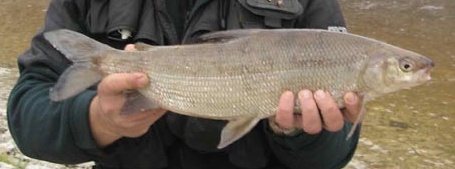
Whitefish live in Karelia, in the lakes of the Northwestern region and in the reservoirs of Siberia. The whitefish genus has many species, subspecies and forms. River and lake whitefish are known to lead a steamboat lifestyle. Accordingly, their sizes vary: there are adult whitefish weighing several tens of grams, and others weighing 7-8 kg or more. Based on the characteristic features of their body structure and lifestyle, whitefish are divided into several species. Different types of whitefish interbreed easily.
The number of gill rakers on the first gill arch is usually taken as the basis for morphological features. Based on this characteristic, whitefish are divided into three groups: small-stamened (up to 30 stamens), medium-stamened (30-40 stamens) and multi-stamened (more than 40 stamens). Each of them, in turn, is divided into anadromous and lacustrine forms according to their ecological characteristics (habitat and spawning habitats). In lake forms, the entire life cycle takes place in the lake; migratory whitefish rise from the lake or sea to spawn in rivers, where they spawn in rapids areas. Whitefish juveniles spend the first year of their life in rivers. Both lake and anadromous whitefish differ both among themselves and within their forms, often even within the same reservoir, in size, feeding pattern, and development conditions. In all large Karelian reservoirs, several varieties of lake and migratory whitefish have been identified, usually having local names. Thus, in Lake Onega there are nine main varieties of whitefish - Shuisky, Vodlinsky, Sunsky, Ludoga, Yamny, etc. This number can be increased if we take into account the ecological forms characteristic of each large bay. Seven varieties of whitefish, associated with certain areas, are counted in Lake Ladoga - Vuoksinsky, Ladoga black, Yamnaya, or Valaamka, Ludoga, Volkhovsky, Svirsky. Ladoga lake The same number is in Segozero. six different species in the Topo-Pyaozersk reservoir. One or several varieties of whitefish were also found in many other, smaller lakes of the republic - Syamozero (two), Vedlozero (one), Yanisyarvi (two), lakes Kuito (four), Nyukozero (three), Engozero (two), Keret -lake (two), Ondozero (one), etc. Almost all whitefish in our reservoirs are freshwater fish. Only the Arctic Sea whitefish lives in coastal desalinated sea waters. In the White Sea, this is a large (weight up to 2 kg) form of anadromous whitefish, which comes to breed in many White Sea rivers - Kem, Vyg, Pongoma, Gridinka, Keret, Northern Dvina, etc. Lake whitefish living in Karelia form several ecological forms , whose lifestyle is associated with certain natural conditions of the reservoir or its parts. In Lakes Ladoga and Onega, the most numerous form of lake whitefish, ludoga, is widespread. It owes its name to its predominant habitat on luds - rocky accumulations at the bottom of lakes. Here this whitefish finds its favorite food - relict crustaceans of mysids and amphipods. Ludoga is a cold-loving form. As the water temperature warms up to 16-18°, this whitefish leaves the pools and sinks into the pits. In the autumn, when the water cools to 2-3°, the ludoga approaches the coastal strip of lakes, where it spawns (also on ludas), while intensively eating both its own eggs and the eggs of vendace on its spawning grounds. Ludoga is a relatively small whitefish, its usual size does not exceed 40-45 cm, and its weight is 800 g. The Yamnaya whitefish also lives in Lakes Ladoga and Onega, called “valamka” in Lake Ladoga, and “zobaty” in Lake Onega. This is one of the largest forms of whitefish: an average weight of 0.8-1 kg with a length of 40-50 cm, but there are specimens weighing up to 2 kg. Yamny whitefish is the deepest form of whitefish in Lakes Ladoga and Onega. It lives at depths of up to 150 m, prefers muddy soils, where it feeds on various benthic organisms - mysids, amphipods pallasea and pontoporea, chironomid larvae; At depths (rocky ridges) spawning occurs. In Lakes Ladoga and Onega, other forms of lake whitefish are also distinguished, differing in morphological characteristics, size and weight indicators, as well as attachment to certain areas of the reservoir. A significant number of local forms of lake whitefish are also found in smaller water bodies. Thus, in Topozero and Pyaozero there are two such forms - Rantasiyka (shore) and Lattaneni (deep-sea) whitefish, in Segozero - four (molga, lake summer, lake multi-stamen, ludoga), at the same time in many lakes lake whitefish in no special form is distinguished. Among migratory lake-river whitefish there are no fewer forms that differ in morphological and biological characteristics than among lake whitefish. Moreover, in large bodies of water, a larger number of such forms and varieties are usually found. Thus, in Pyaozero, four forms of migratory whitefish are known: lehtisiga is a medium-sized (weight about 500 g) whitefish, the first, compared to other migratory whitefish, to go to spawn in rivers (Sofyangu and its tributaries Lonchu and Varbu; Tavangu, Karmangu, etc. ); kutcheri - small (average weight about 300 g), slow-growing whitefish, breeding in almost all tributaries of the Pyaozer, going to spawn after lehtisig (from the first days of October until freeze-up); Kukkoneni is the smallest of the Pyaozero whitefish (average weight about 150 g), the last to rise to spawn (from November until freeze-up). Previously, another form of migratory whitefish was found in Pyaozero - suuri whitefish, the largest whitefish of this reservoir (weighing up to 2 kg, and some individuals even up to 3-4 kg), this whitefish was distinguished by its summer spawning migration (to the Sofyanga River). Due to the small number, information on its biology is very scarce. In Segozero, three forms are distinguished among migratory whitefish: Neshko - small (average weight 180 g) whitefish with an early autumn (September) spawning run (into the Sona River); mushtasiga - medium-sized (average weight 400 g) whitefish with an autumn run (September-October) (in the Luzhma and Sona rivers); pilone—very small (average weight 60-80 g) Segozero whitefish with a late-autumn spawning run (in Pinema Creek). Migratory whitefish of Lakes Onega and Lake Ladoga are usually divided into separate spawning herds, the names of which are determined by the name of the river that serves as the breeding site of the corresponding herd. So. In Lake Onega, there are three herds of migratory whitefish: Shuya, the most numerous at present; Vodlinskoe (Shalskoe) and Sunskoe are extremely small in number and non-commercial, although in former times catches exceeded 30 tons. The diversity of ecological forms also determines significant differences in the biology of whitefish. Among them we find typical benthophages (Yamnaya whitefish, ludoga, Rantasiyka, Lattaneni, Segozersky summer lake whitefish) and whitefish with a mixed type of nutrition (benthic and planktonic) - Segozersky lake multi-stamen, Syamozero lake multi-stamen, Shuya anadromous. In the diet of some whitefish (Vodlinsky whitefish, Neshko), aerial insects occupy a prominent place. Whitefish are also characterized by predation, and both the fish themselves and their eggs can become victims of predatory feeding. Most of the whitefish in our reservoirs are fish with an average lifespan of up to 8-12 years, only a few forms (Shuysky, Yamny, Rantasiyka) are long-lived (maximum age 18-20 years). The polystamen lake whitefish from Syamozero has the shortest life expectancy - it lives only 6 years, and becomes sexually mature at the age of 2-3 years. Most other whitefish mature at 4–6 years of age. Most whitefish spawn in the fall (October-November), some forms (valamka, Ladoga black, kilone) spawn already at the beginning of winter (December). The fertility of whitefish fluctuates quite a bit and, like most fish, increases with age. In a number of small whitefish from relatively small lakes it is only 3-6 thousand eggs, in many lake forms (Onega Ludoga, Rantasiyka, Segozersky Lake Summer, Kutcheri) it is usually within 10-15 thousand eggs. Only some large whitefish (Vodlinsky, Valaam-ka, Ladoga Ludoga) can have 30-40 thousand eggs in their ovaries. Whitefish is a valuable commercial fish in northern waters. Whitefish is also very popular in recreational fishing - in early spring (March-April), amateur fishermen willingly go ice fishing for whitefish using winter lures.
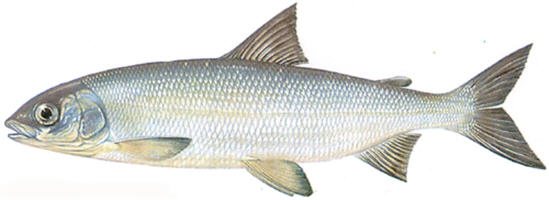
Peled is capable of eating both plankton and bottom organisms. The growth rate of different whitefish varies. The common whitefish is considered to grow quickly, but, according to the latest information, peled in good conditions grows even faster. The slowest growing species of whitefish is whitefish. Whitefish spawn in September-December. Spawning occurs on pebble bottoms or on reefs, often in standing water. Females do not lay eggs. Peled spawn later than other whitefish, and its eggs are much smaller. It feeds throughout the year, including in winter.
Whitefish life cycle
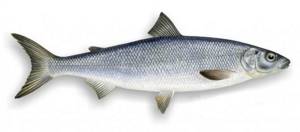
The life cycle of a whitefish begins from the moment the larva emerges from the egg. This process is quite lengthy. After fertilization of the eggs, the incubation period begins, which can last for 200 days. Larvae emerge from the eggs and begin to grow and feed on plankton. Unfortunately, not all larvae will survive to become adults. Many will be eaten. Those larvae that survive will actively gain weight and length. Fry, whitefish are considered after reaching 3-4 centimeters in length. The whitefish will remain in the fry state for about a year, then it becomes a juvenile. The life of a growing whitefish changes. The younger the fish, the closer to the shore and surface of the water it feeds. As fish age, they sink closer to the bottom. The lifespan of fish is on average 15-20 years. Sexual maturity in males occurs at 4 years, and in females several years later. The fish spawns in the same place where it once emerged from its eggs. After spawning, the fish do not die. Whitefish are capable of spawning for many years in a row. To spawn, the fish gather in schools and move up the river. Spawning begins around September and can continue until December. After spawning, the fish are sent to their habitats, and the life cycle for new fish begins.
SIG in the lakes of Karelia. Whitefish fishing methods
Among the vast family of salmon fish inhabiting the waters of Karelia, whitefish occupies a worthy place. Adult whitefish can reach a considerable weight, up to several kilograms. At the age of three, whitefish spawn for the first time, in the fall or early winter. Among the vast family of salmon fish inhabiting the waters of Karelia, whitefish occupies a worthy place.
Adult whitefish can reach a considerable weight, up to several kilograms. At the age of three, whitefish spawn for the first time, in the fall or early winter.
Usually it stays at depth and only occasionally appears in shallower places. Its food consists of various crustaceans and insects.
Spring-summer fishing for whitefish begins immediately after the snow melts, and then when the water becomes clean and transparent. Amateur fishermen usually catch whitefish with a lightweight fiberglass rod, which allows them to make long casts, maneuver the tackle, and catch large fish. The diameter of the main line is 0.22-0.25 mm, the leads - 0.15-0.17 mm. The float is usually simple: an elongated foam plastic float with a long antenna and a small keel, but weighted. Several sinkers are used, with the heavy sinker placed closer to the float, and the smallest one near the hook. Reels use inertial ones. An important part of the equipment is a small jig with a cambric attached to the hook.
Since the beginning of summer is marked by a massive flight of mosquitoes, which gather in clouds over the water, while often falling into this water, the whitefish does not sleep at this time.
You, in turn, have an excellent opportunity to catch whitefish. From mid-July with the onset of heat and almost until September, biting is not acceptable due to the fact that nature gives the whitefish a lot of natural food in the form of insects, and your bait is unlikely to interest it.
As mentioned above, whitefish begin to spawn in mid-autumn, so they begin to feed heavily before spawning, and during this period of time the bite resumes. At the same time, you can even catch whitefish from the shore, albeit small ones, but large ones - near the fairway, the deeper part of the river.
The whitefish bite is very sharp. Taking off diagonally towards the floating bait, it lies on its side, and having grabbed the prey, it goes into the depths, while the float, as a rule, dives sharply. But there is an exception, because whitefish, judging by its habits, is a cunning fish. Having taken the bait, he may not move, in this case the float begins to slowly sink, and you get the impression that a hook has occurred. After hooking, the whitefish begins to stubbornly resist. Therefore, from a boat, as in the case of salmon, it is more convenient to fish together, helping each other when fishing. Often this cunning one dives under the boat, and when it is brought to the shore, he lies on his back and goes into the depths. As he does so, the hook flies out of his mouth.
Whitefish fishing methods
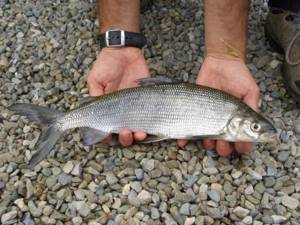
Before you go fishing for whitefish, you should research what type of fish is allowed to be caught and in which region. Some types of whitefish are protected by law. In Russia, catching the population of Volkhov and Baunt whitefish is prohibited. The common whitefish is also protected in some regions of the country.
Fishing for whitefish will be successful if you thoroughly prepare for the catching process and study the character traits of this fish. Experienced fishermen know that whitefish prefer deep areas, which means they should be caught in the deepest parts of rivers and lakes. Ideal places with riffles. In the morning and evening, fish can bite near the shore. Whitefish are very voracious fish; they do not stop feeding even in winter. Whitefish should be caught using live bait. Fish from the whitefish diet would be ideal: smelt, bleak, roach. The ideal bait length is 8 centimeters. If the fisherman does not have live bait at his disposal, then pieces of crab meat, shrimp or mussels will be used. The whitefish that live in the river happily grab silicone baits, but whitefish are difficult to catch with a worm.
Whitefish fishing will vary with the seasons. In the summer, whitefish are caught with a spinning rod equipped with spoons. In autumn, a bottom fishing rod with bait - maggots - is effective. In winter, classic ice fishing rods are used. Whitefish is a very neat and cautious fish. An experienced fisherman can catch it, since successful fishing requires a certain level of skill.
Lure fishing
Once they reach a certain age, whitefish become predators. Their diet, which previously consisted mainly of small animals, is replenished with fry. Therefore, if there are medium and large specimens in the reservoir, excellent results can be achieved with balancers and winter lures.
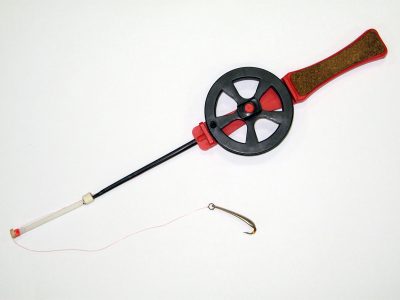
Tackle for catching whitefish in winter using spoons is not particularly different from pike perch. To troll, you will need a short fishing rod equipped with an open reel and a Mylar nod, as well as a certain supply of monofilament (for fishing a large whitefish - 0.18-0.2 mm, for a medium one - 0.14-0.16). Sometimes, if the bite is too weak, it is useful to replace the standard fishing line with a thinner one.
In recent years, fishermen are increasingly using winter spinning rods up to 50 cm long to catch whitefish from the ice. They are equipped with lightweight spinning rods and a braided cord with a diameter no thicker than 0.12 mm. Since braid can scare away fish, an invisible fluorocarbon leader must be tied to its end. Of course, on frosty days it is not very convenient to use the cord, since it freezes heavily, but when fishing at great depths, thanks to it, the tackle acquires the necessary sensitivity.
As already mentioned, the baits for such fishing are spoons and balancers.
A hungry whitefish will take any lure, but it still has its own preferences. The best “provocateurs” are considered to be elongated silver spoons that look like a small fish.
Two-tone models work well, with one side silver and the other gold. The size of the bait ranges from 4-7 cm.
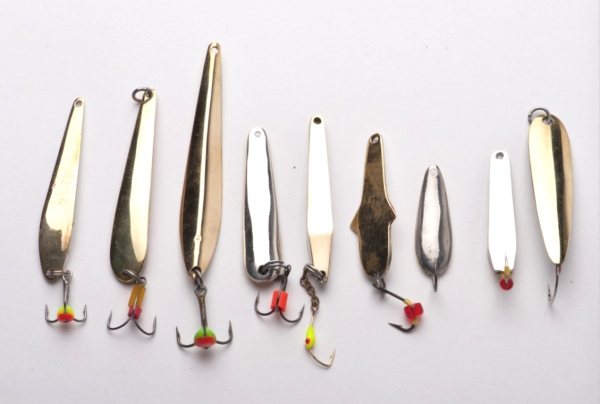
There is an opinion that for big fish you need to put a larger bait, but for whitefish this rule is not relevant. It happens that a real “monster” that does not fit in the hole takes a miniature spinner. To make it more attractive, the tee of the whitefish spoon is equipped with bright plumage - a bunch of red threads. If it has a single hook, then its fore-end can be decorated with colored beads or cambrics.
The balancer is another effective bait for catching whitefish from the ice. As a rule, small products up to 5 cm long, painted in natural colors, are used. For example, gray, silver, blue or a combination of them. The size and weight of the balancer are selected taking into account fishing conditions, especially depth.
Flashing whitefish does not imply and even excludes high sharp strokes with a fishing rod, as when catching perch or pike perch. This might scare him away. The spoon is stopped 10 cm above the bottom, and then it is smoothly thrown up to the same height and the fishing rod is immediately returned to its original position. After a 5-second pause at the bottom point, a short swing again and so on. If the fish ignores the bait in the water column, you can play with it on the bottom: move it, knock on the surface, raise a little mud and slowly lift it. Most often, a bite occurs at the moment of stopping.
Gastronomic value of whitefish
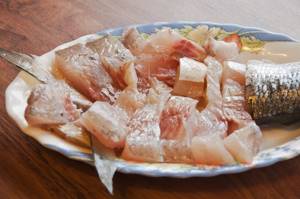
The whitefish population is noticeably suffering due to the commercial value of this fish. Fish meat has practically no small bones. The meat is white and low in calories. The meat has beneficial properties and is enriched with minerals and vitamins, including fluorine, zinc, iodine, vitamin A, B, PP. The meat contains Omega 3, which is why meat is indicated for people to improve immunity and recovery. Whitefish meat is useful for anemia and problems with the endocrine system. Meat can be consumed in various forms, smoked and salted, fried and dried. In any form, whitefish meat has an excellent taste. Meat is low in calories and will be useful for people following a healthy diet. Pink whitefish caviar is considered valuable, which is equivalent to salmon caviar. Whitefish meat is a real delicacy that will please a gourmet.
Whitefish is a bright representative of his family, with an amazing character. The fish is very tasty and highly valued among gourmets. Fishing for whitefish will bring real pleasure to the angler, because not everyone can catch this fish.
Breeding whitefish in cages on the lake.
Physiological state of Volkhov whitefish producers during the spawning period
In 2004–2008
studied the physiological state of Volkhov whitefish breeders (Coregonus lazaretus baeri Kessler) from broodstocks raised in industrial conditions using the biotechnology of the Federal State Scientific Institution "GosNIORH" and from the natural population of the river. Volkhov. Broodstock of whitefish are kept in cages installed in the lake. Sukhodolskoe on the basis of the fish breeding enterprise 000 “Forvat” (Leningrad region). The primary stock was formed from larvae obtained in 2001 - 2002. at the Volkhov fish hatchery and grown in pools and trays on artificial feed. In 2004–2005 these juveniles reached the age of sexual maturity, and from their offspring a first-generation broodstock was formed, the broodstock of which matured in 2008. The control was spawners of Volkhov whitefish from the natural population, caught by the Volkhov fish hatchery in the lower reaches of the river. Volkhov (2007).
As is known, the prespawning period in whitefish is characterized by the mobilization of body reserves for the needs of gametogenesis and a negative fat balance: the content of total lipids in the body decreases significantly, cavity fat practically disappears. During the period of maturation of reproductive products, nutrients and biologically active substances are redistributed from the tissues and liver of fish and accumulate in the Gonads. Such changes can be seen especially clearly in salmon and whitefishes that make long spawning migrations (Reshetnikov, 1966; Reshetnikov et al., 1970; Shulman, 1972, 1978; Chechenkov, 1973, 1978; Lizenko et al., 1975).
Our studies (July-November 2005) showed that the maturation of reproductive products in four-year-old whitefish spawners spawning for the first time in cages was also accompanied by a decrease in lipid metabolism. The relative mass of cavity fat, the content of total lipids in the muscles and liver of whitefish at the final stages of gametogenesis (spawning, November) turned out to be 1.1-3.5 times lower compared to the indicators of four-year-olds at the early stages of gametogenesis (II – III, July) . However, the formation of gonads in whitefish occurred against the background of intense protein growth. The increase in whitefish weight was almost 50%, length - 8-10%, protein levels in the muscles increased by 2-8%, accumulation of vitamins and carotenoids was noted not only in the gonads, but also in the liver. At the same time, the fat content in the testes decreased by 1.4 times, in the ovaries - by 3.5 times. Many physiological and biochemical indicators of first-ripened four-year-olds in cages, especially females, were significantly higher than those of breeders from the river. Volkhov (Table 1).
The physiological state of repeated spawning males and females (4+) from the primary broodstock was more consistent with that of the producers of the spawning population of the river. Volkhov. Five-year-old spawners in cages differed from individuals caught in the river only in higher body condition and the level of fat in the body cavity, muscles and liver, which is primarily due to the absence of spawning migration.
The quality of the reproductive products obtained from them is closely related to the physiological state of producers. The above-mentioned differences in physiological parameters between sires at the age of 3+ and 4+ also determined the differences in the biochemical composition of eggs obtained from first-time and repeat spawning females of the primary stock. The content of protein and vitamins in the eggs of first-ripened females (3+) was slightly lower compared to females aged 4+ (Table 2).
The composition of caviar obtained from first-spawning female Volkhov whitefish (3+) from the primary broodstock (2004–2005) also differed from whitefish caviar ripened under natural conditions. The total supply of nutrients in the eggs of cage females was 4-6% higher, but the share of total protein in dry matter was only 52-53%, while in the eggs of females from the river. In Volkhov, this figure reached 66%. Eggs from caged females were characterized by higher levels of total lipids and low vitamin content. In re-spawning females (4+) of the industrial stock, the general composition and content of biologically active substances in the game were practically no different from the indicators of eggs of females from the river. Volkhov. This indicates the good quality of eggs from five-year-old cage fish and confirms the data on the normal physiological state of females aged 4+.
In 2008, eggs were obtained for the first time from females of the first generation. In the process of raising spawners of this generation (2005–2008), the biotechnology of keeping and feeding Volkhov whitefish in cages was improved, which had a beneficial effect on the quality of eggs of four-year-old females spawning for the first time. The biochemical composition of the caviar obtained from them fully corresponded to the quality of whitefish caviar from the river. Volkhov.
Table 1 Physiological and biochemical parameters of Volkhov whitefish producers
| Index | cages | R. Volkhov | |||||
| 3+(8.11.2005) | 4+(8.11.2005) | 3±4+(2.11.2007) | |||||
| Weight, g | 754±39,4 | 640±43,9 | 1065±65,9 | 1082±76,4 | 239±85,6 | 794±70,6 | |
| Length, cm | 35,2±0,94 | 35,6±0,50 | 39,9±0,56 | 38,8±0,67 | 47,7±0,78 | 40,2±1,16 | |
| Coeff. fatness according to Fulton | 1,7±0,12 | 1,4±0,07 | 1,7±0,04 | 1,8±0,08 | 1,1±0,05 | 1,2±0,02 | |
| Liver index, % | 1,2±0,04 | 1,0±0,05 | 1,1±0,05 | 1,2±0,09 | 1,2±0,24 | 1,2±0,06 | |
| Cavity index fat,% | 1,0±0,26 | 0,5±0,16 | 0,7±0,08 | 0,3±0,10 | 0 | 0,1±0,05 | |
| Content in muscles (raw matter), % | |||||||
| Water | 71,0±0,77 | 75,0±1,21 | 69,7±1,10 | 67,7±0,66 | 73,4±0,63 | 75,0±0,86 | |
| Protein | 19,8±0,60 | 16,7±1,17 | 19,3±0,48 | 19,1±0,48 | 17,6±0,36 | 9,5±0,67 | |
| Fat | 5,1±0,94 | 3,4±0,69 | 5,6±0,57 | 4,1±0,38 | 2,4±0,09 | 2,4±0,37 | |
| Ash | 1,2±0,02 | 1,1±0,02 | 1,1±0,02 | 1,1±0,04 | 1,3±0,02 | 1,3±0,05 | |
| Content in liver (on a crude basis) | |||||||
| Fat% | 5,7±0,97 | 3,4±0,32 | 4,3±0,21 | 3,4±0,66 | 2,8±0,03 | 2,7±0,13 | |
| Vitamin C, mg% | 9,7±1,03 | 9,2±0,71 | 14,3±1,68 | 16,9±1,61 | 15,6±2,03 | 18,0±1,32 | |
| Vitamin A, mg% | 38,1±5,33 | 32,2±6,02 | 39,7±8,05 | 27,4±5,47 | 30,0±7,01 | 8,6±3,41 | |
| Vitamin E, mg% | 51,3±7,40 | 46,3±10,70 | 47,3±11,87 | 50,1±9,60 | 33,8±5,49 | 36,6±2,13 | |
| Carotenoids, mcg/g | 6,3±0,64 | 6,6±0,29 | 6,1±0,45 | 6,5±1,08 | 2,9±1,28 | 3,5±0,55 | |
| Content in gonads (per wet matter) | |||||||
| Water,% | 76,5±2,43 | 75,8±4,06 | 76,9±1,13 | 74,5±3,42 | 76,8±0,51 | 77,8±1,13 | |
| Protein, % | 13,8±1,15 | 15,3±3,26 | 15,0±0,78 | 13,9±0,94 | 15,8±0,40 | 16,1±0,77 | |
| Fat, % | 6,4±0,93 | 5,0±1,39 | 5,3±0,55 | 4,0±0,90 | 4,8±0,14 | 3,8±0,27 | |
| Ash, % | 1,7±0,23 | 1,5±0,05 | 1,4±0,64 | 1,8±0,16 | 1,6±0,06 | 2,3±0,09 | |
| Vitamin C, mg% | 26,9±6,39 | 16,2±0,62 | 23,6±3,12 | 10,4±3,43 | 16,9±0,89 | 10,5±1,21 | |
| Vitamin A, mg% | 17,7±2,52 | 6,4±1,97 | 11,9±1,42 | 7,7±2,64 | 7,5±0,50 | 8,3±0,91 | |
| Vitamin E, mg% | 52,6±9,58 | 35,0±6,71 | 38,0±12,10 | 25,5±7,04 | 32,8±7,12 | 19,8±1,76 | |
| Carotenoids, mcg/g | 7,9±0,63 | 3,5±0,77 | 7,2±1,39 | 4,39±0,82 | 5,0±0,60 | &1,4±0,31 | |
Table 2 Biochemical composition of ovulated Volkhov whitefish eggs
| Substance (wet weight) | cages | R. Volkhov | ||||
| 2004; | 2005 | 2006 | 2008 | 2007 | ||
| 3+ | 3+ | 4+ | 4+ | 3+ | 3+-4+ | |
| Water,% | 68,3±0,83 | 69,5±0,86 | 70,8±0,72 | 69,7±0,83 | 70,6±0,91 | 73,4±0,63 |
| Dry matter,%; | 31,7±0,83 | 30,5±0,86 | 29,2±0,72 | 30,3±0,83 | 29,4±0,91 | 26,6±0,63 |
| Protein,% | 16,4±0,90 | 16,3±0,47 | 17,8±0,41 | 17,1±0,67 | 17,0±0,58 | 17,6±0,63 |
| Fat,% | 6,2±0,33 | 6,0±0,52 | 5,0±0,12 | 5,3±0,20 | 5,1±0,46 | 4,4±0,29 |
| Ash,% | 1,3±0,02 | 1,3±0,03 | 1,3±0,02 | 1,3±0,02 | 1,2±0,02 | 1,3±0,01 |
| Vitamin C, mg% | 12,9±1,66 | 13,7±0,90 | 15,6±1,16 | 17,7±2,36 | 18,3±0,73 | 16,9±0,89 |
| Vitamin A, mg% | 3,9±0,39 | 3,4±0,51 | 6,6±0,86 | 6,8±2,04 | 6,7±0,89 | 7,5±0,50 |
| Vitamin E, mg% | 17,7±1,61 | 20,9±3,24 | 30,9±4,76 | 34,2±2,27 | 33,3±2,14 | 32,8±3,12 |
| Carotenoids, mcg/g | 6,0±2,45 | 5,7±2,42 | 5,8±0,77 | 6,3±0,59 | 7,0±0,47 | 5,0±0,60 |
Conclusions:
The presented results indicate that the biotechnology developed at the State Research and Development Institute of Organic Chemistry allows one to grow physiologically complete broodstock under industrial conditions and obtain high-quality caviar from them. The creation of production broodstocks of Volkhov whitefish using this technology will ensure the procurement of the required amount of fish eggs for reproduction purposes and will reduce the burden on the natural population. This, in turn, will contribute not only to the conservation of a valuable species, but also to the expansion of the scale of artificial reproduction, an increase in its numbers, and the removal of species included in the Red Book.
A.K. Shumilina FGNU "GosniORH", St. Petersburg
Video: Fish farming in cages
production of fish cages
